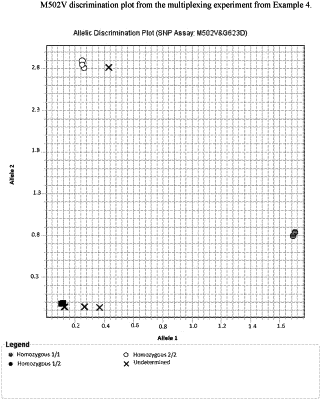| CPC C12Q 1/6883 (2013.01) [C12Q 1/6827 (2013.01); G01N 33/582 (2013.01); C12Q 2600/156 (2013.01); C12Q 2600/16 (2013.01)] | 4 Claims |

|
1. A method for detecting corneal dystrophy (CD) comprising:
(A-1) amplifying one or two DNA regions of interest from a biological sample from a subject using a reaction mixture comprising at least a first amplification primer pair to produce one or two amplified DNA regions of interest;
(B-1) hybridizing a first labeled TGFBI G623D mutant detection probe comprising the nucleotide sequence of SEQ ID NO: 36 and a second labeled TGFBI M502V mutant detection probe comprising the nucleotide sequence of SEQ ID NO: 30 to a first TGFBI gene sequence comprising a region encoding amino acid position 623 in the one or two amplified DNA regions of interest and a second TGFBI gene sequence comprising a region encoding amino acid position 502 in the one or two amplified DNA regions of interest, respectively;
and
(C) detecting CD if the at least G623D and M502V mutations in the one or two amplified DNA regions of interest are detected.
|